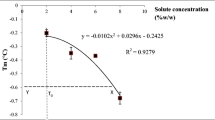Abstract
A study was undertaken with the aim of reducing the concentration of cryoprotectants in surimi without adversely affecting frozen storage stability. Minced meat from a tropical fish, Nemipterus japonicus, was strained, water leached and mixed with different levels of sucrose-sorbitol (1:1) mixture (henceforth called sugar mixture), quick frozen at −35 °C and frozen stored at −20 °C. The surimi samples were subjected to storage stability studies for a period of 5 months. Water leaching resulted in slight absorption of water by meat and reduction in protein, fat and mineral contents. Surimi was found to have moderately white colour. Sensory evaluation studies were conducted on three products, viz., sausage, patty and cake, prepared using surimi containing different concentrations of sugar mixture. Sugar mixture content varying from 0% (control) to 4% in surimi resulted in products that were more acceptable to the taste panelists compared those with 6% and 8% sugar mixture. During frozen storage of surimi pH and total plate count remained nearly steady for all sugar mixture concentrations and throughout the storage period. Moisture content appeared to remain constant during storage, but decreased with increase in sugar concentration. The salt soluble nitrogen content of surimi and gel strength of sausage prepared from it decreased with storage period in all surimi samples, and increased with sugar mixture concentration. Expressible water content of surimi sausage showed an increasing trend with storage period of surimi and a decreasing trend with sugar mixture concentration. Sensory evaluation parameters—elasticity, sweetness and preference—remained more or less steady during storage. However elasticity and sweetness increased and preference decreased with sugar mixture concentration beyond 4%. Elasticity and gel strength of surimi sausage seemed to be much lower for control compared to even the lowest concentration of sugar (2%) used. A concentration of 2 to 4% sucrose-sorbitol mixture is well-accepted by the consumers in products—surimi sausage, patty and cake and at this range of concentration surimi could be well-preserved at −20 °C for at least 5 months.


Similar content being viewed by others
References
AOAC (1975) Official methods of analysis, 12th edn. Association of Official Analytical Chemists, Washington DC
AOAC (1984) Official methods of analysis, 14th edn. Association of Official Analytical Chemists, Washington DC
Chandrasekhar TC, Manisseri MK (1976) A practical manual of fishery products. Department of Fish Processing Technology, College of Fisheries, University of Agricultural Sciences, Mangalore
Chang-Lee MV, Lampila LE, Crawford OL (1990) Yield and composition of surimi from Pacific whiting (Merluccius productus) and the effect of various protein additives on gel strength. J Food Sci 55:83–86
Dey SS, Dora KC (2010) Effect of sodium lactate as cryostabilizer on physic-chemical attributes of croaker (Johnius gangeticus) muscle protein. J Food Sci Technol 47(4):432–436
Gopakumar K (2002) Fishery Products. In: Gopakumar K (ed) Text Book of Fish Processing Technology, Directorate of Information and Publications of Agriculture, ICAR, New Delhi, pp 271-302
Jittinanda S, Kenny PB, Slider SD (2005) Cryoprotection affects physical properties of restructured trout during frozen storage. J Food Sci 70:C35–C42
Karthikeyan M, Dileep AO, Shamasundar BA (2006) Effect of water washing on the functional and rheological properties of proteins from threadfin bream (Nemipterus japonicus) meat. Inter J Food Sci Technol 41:1002–1010
Mac Donald GA, Lelivre J, Wilson NDC (1992) Effect of frozen storage on the gel forming properties of Hoki (Macruronus novaezelandiae). J Food Sci 57:69–71
Matsumoto JJ, Noguchi SF (1992) Cryostabilization of protein in surimi. In: Lanier TC, Lee CM (eds) Surimi technology. Marcel Dekker Inc, New York, pp 357–388
Nasab M, Marzieh A, Intenz I, Ashraf A, Ngadi MO (2005) Protein structural changes during preparation and storage of surimi. J Food Sci 70:448–453
Park JW, Lin TMJ (2005) Surimi: Manufacturing and evaluation. In: Park JW (ed) Surimi and surimi seafood. Taylor and Francis Publishers, Boca Raton, pp 33–106
Radin NS (1981) Extraction of tissue lipid with a solvent of low toxicity. In: Lownstein AM (ed) Methods of Enzymology, vol 72. Academic, New York, pp 5–7
Rousseau B (2004) Sensory evaluation. In: Nollet LML (ed) Handbook of FOOD ANAlysis, vol I. Marcel Dekker Inc, New York, pp 21–38
Rupsankar C (2010) Improvement of cooking quality and gel formation capacity of Bombay duck (Harpodon nehereus) fish meat. J Food Sci Technol 47(5):534–540
Scott DN, Porter RW, Kudo G, Miller R, Koury B (1988) Effect of freezing and frozen storage of Alaska pollock on the chemical and gel forming properties of surimi. J Food Sci 53:353–358
Snedecor GW, Cochren WJ (1968) Statistical methods, 6th edn. Oxford and IBH Publ Co, NewDelhi
Sijo M, Karthikeyan M, Shamasundar BA (2002) Effect of water washing of shark (Scoliodon laticaudus) meat on the properties of proteins with special reference to gelation. Nahrung/Food 2:78–82
Surendran PK, Thampuran N, Nambiar VN, Lalitha KV (2006) Laboratory manual on microbiological examination of sea food, 2nd edn. Central Institute of Fisheries Technology, Cochin
Suvanich V, Jahncke ML, Marshall DL (2000) Changes in selected chemical quality characteristics of channel cat fish frame mince during chill and frozen storage. J Food Sci 65:24–29
Suzuki T (1981) Fish and krill protein processing technology. Applied Science Publishers Ltd, London
Sych J, Lacroix C, Adambounou LT, Castaigne T (1990) Cryoprotective effects of some materials on cod-surimi proteins during frozen storage. J Food Sci 55:1222–1227
Vidal-Giraud B, Chateau D (2007) World surimi market. FAO/Globe Fish Publishers Ltd, Rome
Acknowledgement
We express our sincere thanks to the former Dean, College of Fisheries, Kochi for permitting us to publish this paper and Staff of Department of Processing Technology and Department of Management Studies for the support they have given us for publishing this work
Author information
Authors and Affiliations
Corresponding author
Rights and permissions
About this article
Cite this article
U., P., George, S. Influence of cryoprotectant levels on storage stability of surimi from Nemipterus japonicus and quality of surimi-based products. J Food Sci Technol 51, 982–987 (2014). https://doi.org/10.1007/s13197-011-0590-y
Revised:
Accepted:
Published:
Issue Date:
DOI: https://doi.org/10.1007/s13197-011-0590-y




